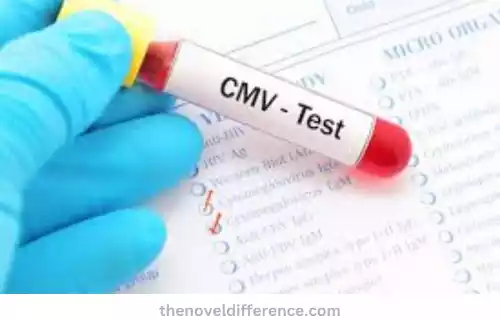Definition of CMV IgG and CMV IgM
CMV IgG: antibodies are specific for Cytomegalovirus (CMV), an infectious herpesvirus-family virus commonly affecting humans and cattle alike. IgG antibodies are the most abundant type of antibodies in the bloodstream and are typically produced during the later stages of an infection or following exposure to an antigen. CMV IgG antibodies indicate a past or latent CMV infection and are generally present in the blood for an extended period, providing long-term immunity against CMV.
CMV IgM: on the other hand, stands for immunoglobulin M antibodies targeting CMV. IgM antibodies are the first line of defense produced by the immune system in response to an infection. They are considered early antibodies and are typically present during the acute or initial phase of infection. CMV IgM antibodies are detectable shortly after CMV exposure or primary infection, and their presence suggests a recent or ongoing CMV infection.
CMV IgG antibodies indicate a past or latent CMV infection, while CMV IgM antibodies point to a recent or active CMV infection. Both types of antibodies play important roles in diagnosing and monitoring CMV infections, but their timing, persistence, and clinical significance differ.
Definition of CMV (Cytomegalovirus)
Cytomegalovirus (CMV) is a member of the herpesvirus family, specifically the Betaherpesvirinae subfamily. It is a common and widespread virus that can infect people of all ages.
CMV infection may spread via various routes, including direct physical contact with bodily fluids like saliva, urine, blood, semen or breast milk; organ transplantation; vertical transmission from mother to fetus during gestation or vertical transmission through motherhood itself.
CMV infections can occur in healthy individuals, but they are often asymptomatic or cause mild flu-like symptoms. However, CMV infections can pose serious threats for those with compromised immune systems, including organ transplant recipients, individuals living with HIV/AIDS and newborn babies infected during gestation.
In these populations, CMV can cause pneumonia, hepatitis, retinitis (inflammation of the retina), gastrointestinal disorders, and neurological problems.
Once a person is infected with CMV, the virus remains dormant in the body for life. It can reactivate and cause recurrent infections, especially when the immune system is compromised.
CMV is known for its ability to establish latency, meaning the virus can remain inactive within certain cells, particularly in white blood cells called monocytes and in other cells of the immune system.
CMV is diagnosed through various laboratory tests, including blood tests that detect CMV-specific antibodies (such as CMV IgG and IgM), viral culture, polymerase chain reaction (PCR) testing, and serological assays.
Treatment for CMV infections may involve antiviral medications to reduce symptoms and complications, particularly in individuals with severe disease or compromised immune systems.
It is worth noting that while CMV infections are generally manageable, they can pose significant risks to vulnerable populations. Therefore, preventive measures, such as practicing good hygiene, avoiding close contact with infected individuals, and screening for CMV during pregnancy, are crucial to minimize transmission and potential complications.
Overview of the immune response to CMV Infection
The immune response to CMV infection involves a complex interplay of various components of the immune system.
Here is an overview of the key aspects of the immune response to CMV:
- Innate Immune Response:
-
- The innate immune system is the first line of defense against CMV infection.
- Cells such as natural killer (NK) cells, macrophages, and dendritic cells recognize and respond to CMV.
- NK cells play a critical role in controlling CMV infection by directly killing infected cells and secreting antiviral cytokines.
- Adaptive Immune Response:
-
- The adaptive immune response is a more specific and targeted defense against CMV.
- Antigen-presenting cells (APCs) such as dendritic cells capture CMV particles and present viral antigens to T cells.
- CD4+ T cells (helper T cells) activate other immune cells and facilitate the production of antibodies.
- CD8+ T cells (cytotoxic T cells) directly recognize and eliminate CMV-infected cells.
- B cells produce antibodies, including CMV-specific IgG and IgM, which can neutralize the virus and mark infected cells for destruction.
- Cell-Mediated Immunity:
-
- Cell-mediated immunity plays a crucial role in controlling CMV infection.
- CD8+ T cells recognize and kill CMV-infected cells, preventing the spread of the virus.
- Memory CD8+ T cells develop during the primary infection and provide long-term protection against CMV reactivation or reinfection.
- Humoral Immunity:
-
- Humoral immunity involves the production of antibodies by B cells.
- CMV-specific antibodies, particularly IgG, play a role in neutralizing the virus, preventing its entry into cells, and targeting infected cells for destruction.
- Antibodies can also enhance the function of other immune cells through antibody-dependent cellular cytotoxicity (ADCC) and complement-mediated lysis.
- Tolerance and Immune Evasion:
-
- CMV has evolved mechanisms to evade the immune response and establish latency.
- It can modulate antigen presentation, interfere with cytokine signaling, and inhibit NK cell activity.
- CMV can also undergo antigenic variation, making it challenging for the immune system to mount a sustained response.
The immune response to CMV is dynamic and multifaceted, involving both innate and adaptive components. The interplay between various immune cells and the production of specific antibodies is critical in controlling CMV infection and preventing severe disease.
Understanding the immune response to CMV aids in the development of diagnostic tests, therapeutic interventions, and preventive strategies.
CMV IgG
CMV IgG refers to immunoglobulin G antibodies specific to Cytomegalovirus (CMV). IgG antibodies are a type of antibody produced by B cells in response to an infection or exposure to an antigen. CMV IgG antibodies are typically generated during the later stages of a CMV infection or following exposure to the virus.

Here are some key points about CMV IgG:
- Production and Presence: CMV IgG antibodies are produced by the immune system in response to CMV infection. They circulate in the bloodstream and can be detected through laboratory tests, such as serological assays.
- Timing of Seroconversion: Serological tests for CMV IgG can determine whether an individual has been previously exposed to CMV. After infection, it takes some time for CMV IgG antibodies to develop, typically ranging from a few weeks to a few months. This period is known as seroconversion.
- Persistence: CMV IgG antibodies tend to persist in the bloodstream for an extended period, often throughout a person’s lifetime. Their presence indicates a past or latent CMV infection. However, it’s important to note that the presence of CMV IgG antibodies does not necessarily indicate an active or ongoing CMV infection.
- Clinical Significance: CMV IgG antibodies have several clinical implications:
-
- Immunity and Protection: CMV IgG antibodies provide long-term immunity against CMV, reducing the risk of reinfection or reactivation.
- Past or Latent Infection: Detection of CMV IgG indicates prior exposure to CMV, even if the individual may not have experienced symptoms.
- Diagnostic Testing: CMV IgG testing is used as part of diagnostic panels to confirm past CMV infection, particularly in pregnant women or individuals with suspected immune system disorders.
- Testing Methods: Serological assays, such as enzyme-linked immunosorbent assay (ELISA) or chemiluminescence immunoassay (CLIA), are commonly used to detect CMV IgG antibodies. These tests measure the presence and levels of CMV IgG in the blood.
It is important to interpret CMV IgG test results in the context of an individual’s clinical history and symptoms, as well as considering other factors such as the timing of the infection and the individual’s immune status. A healthcare professional can provide appropriate guidance and interpretation of CMV IgG test results.
Production and presence of CMV IgG antibodies
CMV IgG antibodies are produced by the immune system in response to Cytomegalovirus (CMV) infection.
Here is an overview of the production and presence of CMV IgG antibodies:
- Immune Response: When a person is infected with CMV, the virus invades host cells and triggers an immune response. The immune system recognizes viral antigens and activates B cells, which are a type of white blood cell responsible for antibody production.
- B Cell Activation: B cells encounter CMV antigens either directly or through antigen-presenting cells. This interaction stimulates B cells to differentiate into plasma cells, which are specialized cells that produce and secrete antibodies.
- Antibody Production: Plasma cells produce and release CMV-specific IgG antibodies into the bloodstream. IgG antibodies are the most abundant class of antibodies in the blood and are capable of recognizing and binding to specific CMV antigens.
- Persistence: Once produced, CMV IgG antibodies can persist in the bloodstream for a long time. They are part of the body’s immunological memory against CMV, providing long-term protection and immunity against future CMV infections. The presence of CMV IgG antibodies indicates past exposure to CMV or a latent infection.
- Antibody Levels: The levels of CMV IgG antibodies in the blood can vary among individuals. The quantity of IgG antibodies can increase over time after initial infection, reaching peak levels during the acute phase of the infection and then stabilizing or gradually decreasing during the latent phase.
- Diagnostic Testing: The presence and levels of CMV IgG antibodies can be detected through serological tests, such as enzyme-linked immunosorbent assay (ELISA) or chemiluminescence immunoassay (CLIA). These tests measure the amount of CMV-specific IgG antibodies in a person’s blood sample.
It’s important to note that the presence of CMV IgG antibodies indicates prior exposure to CMV, but it does not necessarily indicate an active or ongoing CMV infection.
CMV IgG testing is commonly used in clinical settings for diagnosing past CMV infections, assessing immune status, and determining the need for further monitoring or interventions, especially in specific populations like pregnant women or immunocompromised individuals.
Interpreting CMV IgG test results should take into consideration the individual’s clinical history, symptoms, and the timing of the infection.
Consulting a healthcare professional is recommended for a comprehensive understanding and appropriate interpretation of CMV IgG test results.
CMV IgM
CMV IgM refers to immunoglobulin M antibodies specific to Cytomegalovirus (CMV). IgM antibodies are one of the first types of antibodies produced by the immune system in response to an acute or recent infection. CMV IgM antibodies are generated in the early stages of CMV infection or shortly after exposure to the virus.

Here are some key points about CMV IgM antibodies:
- Production and Presence: CMV IgM antibodies are produced by B cells in response to CMV infection. They are typically detectable in the blood within 1-2 weeks after the onset of infection or exposure.
- Timing of Seroconversion: Serological tests for CMV IgM antibodies are used to detect recent or acute CMV infection. The presence of CMV IgM indicates an ongoing immune response against the virus.
- Duration of Antibodies: CMV IgM antibodies are relatively short-lived compared to other antibody types. They generally remain detectable in the blood for a few weeks to a few months before gradually declining or disappearing.
- Clinical Significance: CMV IgM antibodies have several clinical implications:
-
- Acute or Recent Infection: Detection of CMV IgM antibodies suggests an active CMV infection or a recent exposure to the virus.
- Monitoring Immunocompromised Individuals: CMV IgM testing is important for monitoring CMV infections in individuals with compromised immune systems, such as transplant recipients or those with HIV/AIDS.
- Diagnostic Testing: CMV IgM tests are commonly used as part of diagnostic panels to confirm recent CMV infection, especially in cases where symptoms are present.
- Testing Methods: Serological assays, such as ELISA or CLIA, are used to detect CMV IgM antibodies. These tests measure the presence and levels of CMV-specific IgM in the blood.
It is important to note that CMV IgM results should be interpreted in conjunction with clinical symptoms, history of exposure, and other laboratory findings.
False positives or false negatives can occur with CMV IgM testing, so confirmatory testing and consultation with a healthcare professional are recommended for accurate diagnosis and interpretation.
CMV IgM antibodies play a significant role in identifying recent CMV infections and assisting in the clinical management of individuals with suspected or confirmed CMV infection.
Production and presence of CMV IgM antibodies
The production and presence of CMV IgM antibodies occur during and following an acute or recent Cytomegalovirus (CMV) infection.
Here is an overview of the production and presence of CMV IgM antibodies:
- Immune Response: When a person is infected with CMV, the virus triggers an immune response. The immune system recognizes CMV antigens as foreign and initiates a series of immune reactions to eliminate the virus.
- IgM Antibody Production: During the early stages of CMV infection, B cells are activated and undergo differentiation into plasma cells. These plasma cells produce and secrete CMV-specific IgM antibodies as a response to the viral antigens.
- Early Detection: CMV IgM antibodies are among the first antibodies to appear in the bloodstream after infection or exposure to CMV. They are typically detectable within 1-2 weeks following infection.
- Persistence: CMV IgM antibodies have a relatively short duration in the bloodstream compared to IgG antibodies. They tend to persist for a few weeks to a few months following the initial infection or exposure, gradually declining over time.
- Clinical Significance: CMV IgM antibodies have important clinical implications:
-
- Acute Infection: The presence of CMV IgM antibodies indicates an active or recent CMV infection, suggesting that the individual is in the early stages of the infection.
- Screening and Diagnosis: CMV IgM testing is used as part of diagnostic panels to confirm recent CMV infection, particularly in cases where symptoms are present or in certain populations such as pregnant women or immunocompromised individuals.
- Testing Methods: CMV IgM antibodies are detected through serological tests, such as enzyme immunoassays (EIAs) or chemiluminescence immunoassays (CLIAs). These tests measure the levels of CMV-specific IgM antibodies in a person’s blood sample.
It is important to note that CMV IgM test results should be interpreted in conjunction with clinical symptoms, medical history, and other laboratory findings.
False positives or false negatives can occur with CMV IgM testing, so confirmatory testing and consultation with a healthcare professional are recommended for accurate diagnosis and interpretation.
CMV IgM antibodies are produced during the acute or recent phase of CMV infection. Their presence indicates an ongoing immune response to CMV and aids in the diagnosis and monitoring of acute CMV infections.
Differences between CMV IgG and IgM
There are several key differences between CMV IgG and IgM antibodies.
Here is a comparison of CMV IgG and IgM:
- Timing of Production:
-
- CMV IgG: IgG antibodies typically appear later in the course of a CMV infection, usually a few weeks to a few months after infection or exposure. They persist for an extended period, often throughout a person’s lifetime, indicating past or latent infection.
- CMV IgM: IgM antibodies are among the first antibodies to appear during an acute or recent CMV infection. They are detectable within 1-2 weeks following infection and tend to persist for a shorter duration, generally a few weeks to a few months.
- Significance:
-
- CMV IgG: The presence of CMV IgG antibodies indicates past exposure to CMV, providing long-term immunity and protection against future infections. It suggests previous infection or latent infection, but not necessarily active disease.
- CMV IgM: The presence of CMV IgM antibodies suggests an ongoing or recent CMV infection. It indicates an active immune response against CMV and is used to diagnose acute or recent infections.
- Persistence:
-
- CMV IgG: IgG antibodies persist in the bloodstream for a long time, often throughout a person’s lifetime. They provide long-term immunity and protection against CMV reinfection.
- CMV IgM: IgM antibodies have a relatively short duration in the bloodstream compared to IgG antibodies. They tend to decline or disappear within a few weeks to a few months after the initial infection.
- Diagnostic Value:
-
- CMV IgG: CMV IgG testing is commonly used to determine past CMV exposure, assess immune status, and provide evidence of immunity. It is also useful for monitoring individuals with latent CMV infections.
- CMV IgM: CMV IgM testing is used to detect recent or acute CMV infections. It aids in diagnosing active CMV disease, particularly in individuals with symptoms suggestive of recent infection.
- Testing Methods:
-
- CMV IgG: Serological tests, such as enzyme-linked immunosorbent assay (ELISA) or chemiluminescence immunoassay (CLIA), are used to detect CMV-specific IgG antibodies in the blood.
- CMV IgM: Serological tests, such as ELISA or CLIA, are used to detect CMV-specific IgM antibodies in the blood.
It’s important to note that CMV IgG and IgM antibodies provide different information about CMV infection. The combination of CMV IgG and IgM testing, along with clinical evaluation, helps in diagnosing and understanding the stage of CMV infection, determining immune status, and guiding appropriate management and treatment decisions.
Consulting with a healthcare professional is essential for the accurate interpretation of CMV IgG and IgM test results.
What are the similarities between CMV IgG and IgM?
While CMV IgG and IgM antibodies have distinct characteristics, there are some similarities between them. Here are a few similarities:
- Indication of CMV Infection: Both CMV IgG and IgM antibodies are associated with Cytomegalovirus (CMV) infection. Their presence in the bloodstream indicates exposure to CMV, whether it is a recent or past infection.
- Produced in Response to CMV Antigens: Both CMV IgG and IgM antibodies are generated by the immune system in response to CMV antigens. When the body is exposed to CMV, B cells are stimulated to produce these antibodies.
- Detected through Serological Testing: Serological tests such as enzyme-linked immunosorbent assay (ELISA) or chemiluminescence immunoassay (CLIA) can detect both CMV IgG and IgM antibodies present in an individual’s blood sample. These tests measure the presence and levels of these antibodies.
- Clinical Significance: Both CMV IgG and IgM antibodies have clinical significance in the diagnosis and management of CMV infections. They provide valuable information about the immune response to CMV and help in determining the stage of infection, assessing immune status, and guiding appropriate interventions.
- Used in Combination: CMV IgG and IgM antibody testing are often performed together to obtain a comprehensive understanding of the CMV infection. The combination of these tests, along with clinical evaluation, aids in differentiating between acute and past infections, assessing the immune response, and guiding treatment decisions.
It’s important to note that while there are similarities, CMV IgG and IgM antibodies have different temporal patterns, durations, and diagnostic implications.
Interpreting the results of CMV IgG and IgM testing requires considering their individual characteristics and context, along with other clinical information. Consulting with a healthcare professional is crucial for accurate interpretation and management of CMV infections.
CMV IgG vs IgM in Tabular Form
Certainly! Here’s a tabular comparison of CMV IgG and IgM antibodies:
| CMV IgG | CMV IgM | |
|---|---|---|
| Timing of Production | Appears later in the course of infection | Appears early in the acute or recent infection |
| Significance | Indicates past or latent infection | Indicates ongoing or recent infection |
| Persistence | Persists for a long time (often lifelong) | Shorter duration (few weeks to months) |
| Diagnostic Value | Determines past exposure, immunity | Detects recent or acute infections |
| Testing Methods | Serological assays (ELISA, CLIA) | Serological assays (ELISA, CLIA) |
| Clinical Implications | Provides long-term immunity, can indicate prior exposure | Indicates active immune response, aids in diagnosis of recent infection |
| Relationship | CMV IgG antibodies may be present alongside CMV IgM antibodies during the acute phase of infection. CMV IgM antibodies may decline as IgG antibodies increase. | CMV IgM antibodies typically appear before IgG antibodies, indicating an earlier stage of infection. CMV IgM levels may decline as the infection resolves. |
Please note that this table provides a general comparison between CMV IgG and IgM antibodies. It’s important to consult with a healthcare professional for a comprehensive understanding and accurate interpretation of CMV antibody test results in specific clinical contexts.
Conclusion
CMV IgG and CMV IgM antibodies play important roles in the immune response to Cytomegalovirus (CMV) infection. CMV IgG antibodies indicate past exposure or latent infection, providing long-term immunity against future CMV infections.
On the other hand, CMV IgM antibodies are produced early in the acute or recent phase of infection, indicating an ongoing or recent immune response against CMV.
CMV IgG antibodies persist for a long time, while CMV IgM antibodies have a shorter duration in the bloodstream. Serological tests can be used to detect and measure levels of both CMV IgG and IgM antibodies for diagnosis, monitoring, and management purposes of CMV infections.
While there are similarities between CMV IgG and IgM antibodies, such as their indication of CMV infection and the use of serological testing, there are also distinct differences in terms of timing of production, significance, persistence, and diagnostic value.




